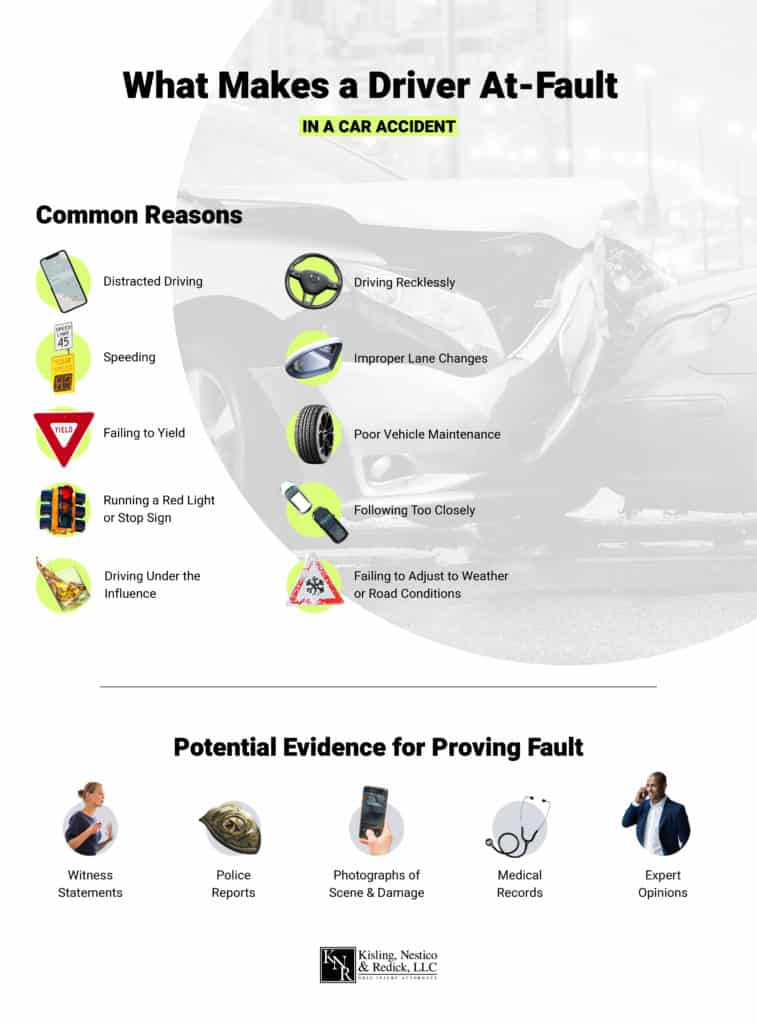Fatal Car Accidents in Cuyahoga County
Posted in: Car Accidents


Car accidents happen in the blink of an eye and often result in significant injuries and losses. While it can be hard to tell exactly what happened and why determining who’s responsible is a big part of dealing with and moving on after a crash.
Assigning blame for a car accident can be difficult and sometimes contentious since the parties involved tend to accuse one another. But in general, fault is assigned to the driver who acted negligently or violated a traffic law. In some cases, you may bear some, if not all, the responsibility.
If you or a loved one were injured in a car accident and have questions about who’s at fault, it’s best to speak to an experienced Ohio car accident lawyer at 1-800-HURT-NOW. At KNR, we will evaluate your case for free and explain your eligibility for compensation, either through an insurance claim or car accident lawsuit.
Ohio is an at-fault state,, which means that the driver who caused a car accident is held liable for the damages and injuries. Therefore, determining fault after an Ohio car accident is vital because the at-fault driver and their insurance company can ultimately be required to pay for any property damage, medical bills, and other costs resulting from the accident.
Identifying the at-fault driver will depend on the circumstances involved, but it’s important to note that fault can also be shared, and it’s up to insurance adjusters or courts to determine fault and liability officially. So, it’s always a good idea to drive safely, follow traffic laws, and consult a lawyer if you are involved in an accident where multiple drivers could share responsibility.
After a car accident, several things could make you the at-fault driver. Here are some common examples:
A driver might be at fault for an accident if distracted while driving. This could include texting, talking on the phone, eating, or any other activity that takes their attention away from the road.
If a driver travels at a speed unsafe for the conditions, they may be at fault for an accident. This could include driving too fast for the weather or road conditions or exceeding the posted speed limit.
Drivers must yield to other drivers in certain situations, such as when merging onto a highway or turning left at an intersection. If a driver fails to yield in these situations and causes an accident, they may be at fault.
If a driver goes through a red light or stop sign, they are breaking the law and putting other drivers at risk. If they cause an accident while doing so, they may be held liable for any resulting damages.
If a driver is under the influence of drugs or alcohol, they are more likely to cause an accident. If they cause an accident while impaired, they may be liable.
Reckless driving is any behavior that puts other drivers at risk, such as weaving in and out of traffic, tailgating, or cutting off other drivers. In addition to a traffic citation, they may be held financially responsible if a driver causes an accident while driving recklessly.
Drivers must use turn signals when changing lanes and ensure it is safe. If a driver fails to use their signals or changes lanes when it is unsafe, they may be considered at fault for an accident.
When a driver fails to keep up with regular maintenance on their vehicle, they risk having a mechanical issue which could lead to an accident. This can be caused by anything from worn tires to faulty brake systems.
You may be deemed at fault if you follow another car too closely and can’t stop in time to avoid a rear-end collision.
If you are driving in poor weather or road conditions, such as rain, snow, or ice, and fail to adjust your driving accordingly, you may be considered at fault.
Evidence is a major part of establishing who was at fault for a car accident and the potential damages to be awarded. Evidence can take many forms, including witness statements, police reports, photographs of the accident scene and vehicle damage, medical records, and expert opinions.
In some cases, the evidence of whether you were at fault may be clear and straightforward. For example, if you were ticketed for reckless driving by the police officer who responded to the scene, that’s strong evidence that you contributed to the accident.
However, in other cases, the evidence may be more complex and require further investigation. This makes it essential to gather as much evidence as possible to support your claim and to consult with an attorney who can help you navigate the legal process.
Assigning fault and financial liability after a car crash typically involves a car accident investigation by the insurance adjusters, law enforcement, and the attorneys representing those involved. The goal is to determine who caused the accident and to what degree. For example, you may be hit by a negligent driver, but if it’s determined that you contributed to the collision by speeding, you may share some culpability.
The investigation will gather materials like witness statements and photos of the accident scene and the vehicles involved and review any available video footage. The parties involved will also consider factors such as the location of the damage to the cars, the position of the vehicles after the accident, and any relevant traffic laws.
After the investigation is complete, the insurance adjusters will determine which driver was at fault based on their findings. Responsibility can be assigned to one or more drivers and can be divided between the parties based on the degree of negligence.
When the parties involved in a car accident disagree about who’s at fault, they may need to pursue a personal injury lawsuit to resolve the matter. In the end, it will be up to the courts to determine fault after a car accident.
If you are unsure if you are at fault for a car accident, you should consult a qualified attorney for legal advice.
Our Ohio car accident attorneys want you to keep more of the compensation you’re entitled to, so you can move on without the pain of uncertainty. At Kisling, Nestico & Redick, we can help you identify who caused your car accident and will use every available resource to hold them accountable.
For a free, no-obligation evaluation of your case, call our personal injury attorneys at 1-800-HURT-NOW today.
View all Car Accidents resources